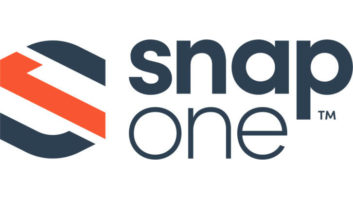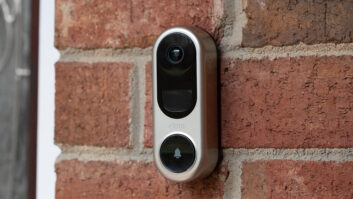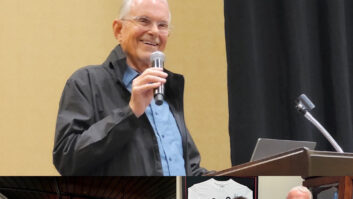There will be a single standard for 5″ digital video discs, thanks to a strong push for a compromise solution to the two-system standoff by Sony and Philips. Their proposal, put straight on the desks of the presidents of the major hardware backers of the Toshiba-Warner SD system and supported by IBM, was adopted as the basis for the development of a universal DVD format.
Refining the agreement into a formal standard will take time, however, and will likely force a postponement of the DVD launch planned by the SD group for June by at least six months. Also in question is the $499 player price point.
The compromise calls for the use of the Toshiba-developed error-correction and higher-density recording systems along with the modulation system of the Sony/Philips MultiMedia CD.
The result is a single- and/or dual-layer disc with 4.7GB capacity per layer and, most critically for Sony and Philips, backward compatibility with existing CD formats.
The capacity per layer is slightly smaller than the 5GB of the SD system, but larger than the 3.7GB of the original MMCD, and it is big enough to store the average-length movie on one layer.
The new standard will have a provision for SD double-sided discs, created by gluing two half-thickness discs together, which would increase the maximum capacity of a single disc to 18.8GB, but they aren’t expected to show up any time soon.
The third time was the charm for Sony and Philips, which first offered a proposal that SD be the DVD format for entertainment and MMCD be the system for data storage. When a follow-up recommendation for a unified standard was rejected, Sony and Philips submitted a proposal directly to the presidents of Hitachi, JVC, Matsushita, Mitsubishi, Pioneer, Thomson and Toshiba.
Along with pressure from IBM and other PC majors, which were demanding a unified DVD system, that was enough to force acceptance by a number of intransigent members of the SD group.
With the hardware issue settled, the movie studios had little choice but to go along as well.
When all parties had apparently agreed, Philips took the point position in getting the message to the media through an international conference call hosted by executive VP Henk Bodt at Philips headquarters in Eindhoven.
Bodt, noting that a name for the new standard was among topics yet to be resolved, said he estimated it would be late fall before a data book could be released to hardware and software companies. He indicated that although both the SD and MMCD systems provided for Dolby AC-3 surround sound, the audio coding for the new system was still unsettled.
In commenting on the disc capacity, Bodt said that a single-sided dual-layer disc would be “adequate for CD-ROM and most video applications.” He doubted that players would need the capacity to play both sides of a double-sided disc without turning the disc over.
Bodt said that Philips expects to have a player “by the end of 1996 or early 1997,” but he declined to comment on pricing. In the past, both Philips and Sony have expressed doubt that initial DVD players could be priced as low as $499. Other companies involved are talking about players priced “at well under $1,000.”
At a follow-up meeting with the media in New York, Jan Oosterveld, president of Philips Key Modules, said a $500 consumer player price was ultimately realistic, but not for next year. Oosterveld considered a DVD recorder a possibility for 1998.
In other news, it was indicated that Philips would again be repositioning CD-i, this time as more of an edutainment product, to move it away from CD-based dedicated game platforms.◊[text]postponement of the DVD launch planned by the SD group for June by at least six months. Also in question is the $499 player price point.
The compromise calls for the use of the Toshiba-developed error-correction and higher-density recording systems along with the modulation system of the Sony/Philips MultiMedia CD.
The result is a single- and/or dual-layer disc with 4.7GB capacity per layer and, most critically for Sony and Philips, backward compatibility with existing CD formats.
The capacity per layer is slightly smaller than the 5GB of the SD system, but larger than the 3.7GB of the original MMCD, and it is big enough to store the average-length movie on one layer.
The new standard will have a provision for SD double-sided discs, created by gluing two half-thickness discs together, which would increase the maximum capacity of a single disc to 18.8GB, but they aren’t expected to show up any time soon.
The third time was the charm for Sony and Philips, which first offered a proposal that SD be the DVD format for entertainment and MMCD be the system for data storage. When a follow-up recommendation for a unified standard was rejected, Sony and Philips submitted a proposal directly to the presidents of Hitachi, JVC, Matsushita, Mitsubishi, Pioneer, Thomson and Toshiba.
Along with pressure from IBM and other PC majors, which were demanding a unified DVD system, that was enough to force acceptance by a number of intransigent members of the SD group.
With the hardware issue settled, the movie studios had little choice but to go along as well.
When all parties had apparently agreed, Philips took the point position in getting the message to the media through an international conference call hosted by executive VP Henk Bodt at Philips headquarters in Eindhoven.
Bodt, noting that a name for the new standard was among topics yet to be resolved, said he estimated it would be late fall before a data book could be released to hardware and software companies. He indicated that although both the SD and MMCD systems provided for Dolby AC-3 surround sound, the audio coding for the new system was still unsettled.
In commenting on the disc capacity, Bodt said that a single-sided dual-layer disc would be “adequate for CD-ROM and most video applications.” He doubted that players would need the capacity to play both sides of a double-sided disc without turning the disc over.
Bodt said that Philips expects to have a player “by the end of 1996 or early 1997,” but he declined to comment on pricing. In the past, both Philips and Sony have expressed doubt that initial DVD players could be priced as low as $499. Other companies involved are talking about players priced “at well under $1,000.”
At a follow-up meeting with the media in New York, Jan Oosterveld, president of Philips Key Modules, said a $500 consumer player price was ultimately realistic, but not for next year. Oosterveld considered a DVD recorder a possibility for 1998.
Also, it was indicated that Philips would again be repositioning CD-i, this time as more of an edutainment product, to move it away from CD-based dedicated game platforms. It also was pointed out that, as DVD will be CD-i compatible, there will be a bigger market for CD-i software.













